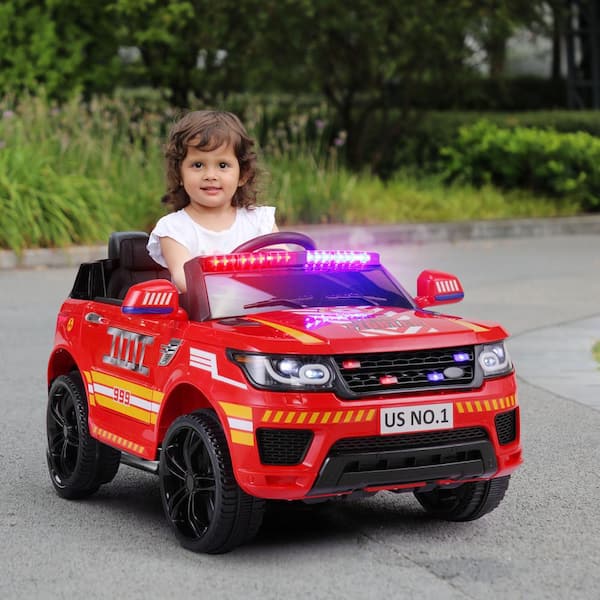Knowing the charging duration and the battery's life span for children who ride electric on their cars will allow you ensure that your kids are entertained for a long time. Here's what you need to know about the battery type -
Most electric rides-on cars are rechargeable and use either led-acid or lithium-ion batteries. The lead-acid batteries take longer time to charge and have less battery life.
Battery Capacity
The capacity of the battery, expressed in ampere-hours (Ah) or Watt-hours (Wh) is the measure of how long the ride-on car will run on a single charge. Larger capacity batteries provide more duration between recharges.
Run Time -
The time of a car's runtime is the amount of time it is able to run continuously on one battery charge. This can vary depending on a variety of factors, including battery's capacity, motor's power, the terrain, and weight of the rider.
Typical electric ride-on car run times range between 30 minutes to two hours on a single charge. Batteries with a large capacity can offer an extended run time.
Charge Time
The charging time is the it takes for the battery to fully recharge after it's depleted. The charging time is contingent on the charger specification as well as the battery's capacity, and charging method.
Charge times vary between 8 and 12-hours for a complete charge for electric rides-on cars. However, certain models provide faster charging times, particularly when using lithium-ion cells.
Battery safety and longevity are dependent on charging the battery in accordance with the guidelines of the manufacturer. The battery's overcharging or undercharging can alter its performance and extend its lifespan.
Charge Methods -
Most electric vehicles include a charging cable that plugs directly into a household outlet. Certain models provide rapid charging or come with a clever charger that monitors and regulates the rate at which a battery is charged.
Make sure whether the charging port on the ride-on car are compatible to avoid damage to either the battery or electrical components.
Additional Batteries
Certain electric rides on cars offer the option to buy additional batteries or spare batteries to play for longer periods of time. With extra batteries in stock it is possible to swap the battery that has been depleted to one that is fully charged to cut down on time.
Understanding the battery and charging time of a kid's car will help ensure that you and your child can enjoy uninterrupted and fun playtime as well as exciting adventures. Utilizing the right charging techniques and charging the battery regularly will maximize battery life. Follow the top rated Lamborghini kids car for more examples including race car toy car, electric car ride, ride ons, ride on toy, car toy toy, car toy car toy, electric ride along car, toy car for car, electric rideons, pedal car and more. .

What Are The Maintenance And Assembly Requirements For Kids' Ride-On Cars?
It is normal for children ride-on vehicles to require some assembly as well as regular maintenance in order to maximize performance and safety. These are some of the most commonly used maintenance and assembly requirements for children's ride-on car.
Most ride-on cars arrive in an unassembled state and need to be assembled upon arrival. Attaching the steering wheel, wheels seats, as well as other parts to the ride-on vehicle as per the directions of the manufacturer is the most commonly used method.
Install the components in accordance with the directions. As directed, complete the assembly using the tools and hardware provided.
Cleaning -
It is crucial to clean the ride-on vehicle regularly to keep its appearance and functionality. Make use of a soft cloth or sponge soaked in moderate soap and water to wipe down the exterior surfaces removing dirt, dust, and debris.
Special attention should be paid to areas that are prone to accumulating, such as tires, wheels, and undercarriage. Utilize a toothbrush or brush to wash hard-to reach places and get rid of stubborn dirt.
Avoid using harsh chemicals and detergents that are abrasive. They could damage electronic parts or the paint on your ride-on vehicle.
Battery Care -
If the vehicle that you ride on is powered by a rechargeable battery taking care of the battery is crucial for maintaining performance and extending the life of the battery. Use these guidelines to take care of your battery -
Charge the battery fully both before and after each use to maximize runtime.
Do not overcharge your battery, or leaving it connected to chargers for a lengthy period. Both of these can harm it and shorten its lifespan.
When not in operation, keep the battery and ride-on cars in a place that is cool, dry, and away from extreme temperatures or direct sunlight.
If needed clean the terminals using an appropriate terminal cleaner or wire brush in the event that they have damaged or corroded.
If the battery no longer charges or shows signs or damage, replace it.
Tire Maintenance -
Check your tires regularly for signs that they're losing pressure, damaged or damaged or worn. Use a bicycle compressor or air compressor to fill the tires up to the pressure recommended by the manufacturer.
Look for debris and foreign objects in the tread pattern, which could cause punctures. Replace the damaged tires and eliminate any obstructions.
Lubricate the wheel bearings, as well as other components to ensure smooth rotation.
Repair or replace components whenever needed
Wear and tear or even accidental damage could cause ride-on car parts to need replacement or repair.
Keep an eye out for indications that your system may be malfunctioning or becoming damaged, including strange sound or behavior and power outages, as well as other abnormalities. For help with troubleshooting or repairs look up the instructions of the manufacturer.
Replace worn or damaged components promptly to prevent further damages and to ensure the safety of your ride on car.
You can be sure that your child's rideon vehicle is in top condition by following these assembly and care instructions. Your child will enjoy numerous hours of safe fun and exciting time. See the best find out more on kids ride on cars for blog examples including car electric ride on, electric car ride, kidscars, electric ride on cars, toy cars, race car toy car, car electric ride on, remote control childrens electric cars, toy in car, remote control childrens electric cars and more. .

What Should I Be Looking For Prior To Purchasing A Children's Electric Vehicle? What Are The Advantages And Cons Of Electric Cars For Children?
If you are considering purchasing an electronic children's vehicle, it is important to take into consideration several factors. Here are some important factors to consider and details about the cost as well as size and pros and cons.
When deciding on an electric vehicle for your child, think about the size and the age of your child. Children who are smaller and younger may choose compact, lightweight cars. However, older children and those with larger bodies might require larger cars that are able to accommodate them comfortably.
Car Dimensions and Weight
Electric kids' car models are available in various sizes. From micro-sized to bigger-scale replicas, they are readily available. The weight and size should be considered according to your child’s age and height as well as their capacity. Also, consider space for storage or play.
Price range -
Prices for electric kids' vehicles vary widely based on factors including brand, size, features and design quality. Smaller models tend to be cheaper, with prices that range from $50 to $200. On the other hand, larger-scale models can range between $200 and $800 or more for top-quality replicas that are licensed.
Pros and Cons -
Pros -
Electric Kids' Cars These cars are great for entertainment and imaginative games. Kids can experience the excitement of having their own vehicle.
Motor Skill Development - Operating an electric car helps children to develop coordination, spatial awareness, and fine motor skills.
Electric cars promote physical and outdoor activities, and exploration.
Realistic Features- Many electric children's vehicles have realistic features, such as working headlights as well as horn sounds. They also work with MP3 players, which improves the experience.
Cons -
Costs - High-quality electronic children's vehicles, particularly replicas that are licensed from the most popular car brands, can be expensive.
Battery Life The power of electric vehicles is supplied through rechargeable batteries. They can have a limited running time and require frequent charging.
Safety Issues - Electric cars could pose safety hazards such as falls, collisions and entrapment, when not used responsibly and with the supervision of an adult.
Maintenance and Assembly Some electric vehicles need assembly upon arrival, in addition to regular maintenance like cleaning, battery care and, occasionally, repairs or replacements of parts.
Features and Accessories
Consider the accessories and features available on the electric cars for children, such as functioning headlights and horn sounds. Also, consider whether the vehicle has an parental remote control, or seat belts. Select a model that has the options and features that best suit your child.
The ideal electric car for kids will depend, in the end on your child's age and their size, as well as their interest as well as your budget. Make sure you study and compare various models review them, then take into account the pros and cons before making a decision. Check out the most popular Audi kids car kidscars.co.uk recommendations for site examples including two seater electric cars, toy toy cars, electric two seater cars, lambo toy car, car toy toy, kids electric cars, electric ride on cars, kids electric cars, ride on toy, ride a toy and more. .
